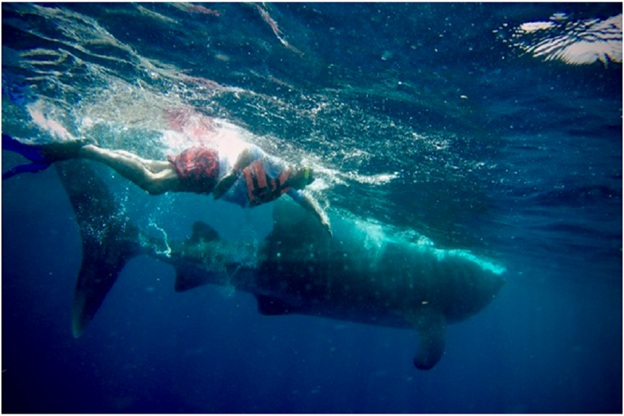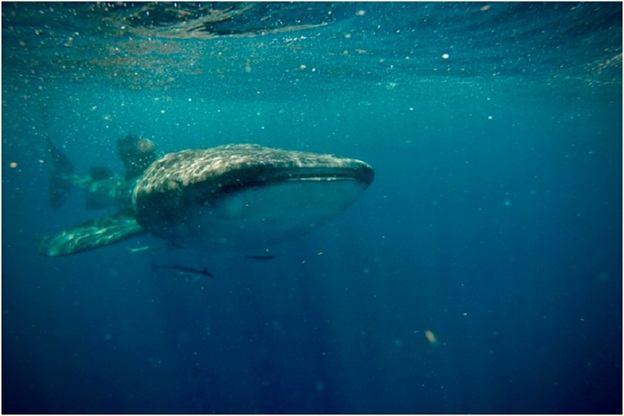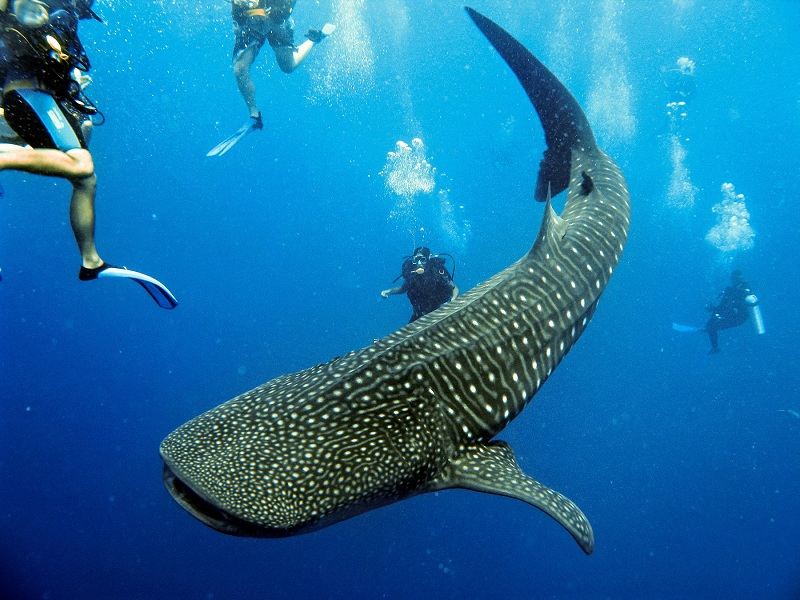It´s just a privilege to go out there and discover the greatness of nature, but this time the adventure went above and beyond. We went to swim with the biggest fish of the world, the whale shark.
On our vacations in the Riviera Maya during the season of Mid April to Mid September the Whale Shark Biosphere in Mexico is open to get to swim with these amazing creatures. Whale watching is on.
The experience is more than amazing, from the moment that you get in the boat the scenery of the Caribbean Sea is great, blue and Tourquoise waters surround us, while we were on the boat, we got to see dolphins jumping and little dark dots, merged on the Tourquoise water that are the turtles that get to shore to lay their eggs in these beautiful white sand beaches.
The boat safari is great, the staff was always there to help us out, they gave us all the equipment necessary, mask, snorkel and life jacket, although we rented wetsuits, that for $15 dollars, was totally worth it, because that protect us from sunburn and we did not have to use the lifejacket while we were in the water, which allows us to swim faster without getting the annoying rash from the life vest.
Our company was Riviera Maya Tourquoise, which is a well known company in the Riviera Maya for the great and welcoming staff, they totally made our life super simple, the traditional food and beverages were offered while we were on the boat, the captain Juan, was great, he seems to know this place like the palm of his hand and well he said that today was a really awesome day, lots of whale sharks around and really calm and clear waters.
But let’s get into details about the actual snorkeling with these amazing creatures.
Our Staff Mac and Tomas, let us know what would be the procedure before we jump, after all we were a group of 10 people. Mac, organized us in couples in order to jump, we were sitting on the starboard side of the boat waiting for the captain to count 1, 2, 3 … our other guide Tomas was next to us ready to jump too while he was taking pictures of the experience.

Finally we saw a massive whale shark coming straight to us, when I said Massive I mean it, a 30 feet long whale shark was coming and then the captain said 3, my wife and I jump, totally overwhelmed our heads came out of the water splashing, and start swimming next to Tomas, he actually hold our hands to help us out reach as fast as possible to the moving creature that was coming up to us, Tomas, set us in a position really close to the whale shark, around like 5m (15 ft) and we start swimming next to it, admiring it, and at the same time my mind couldn’t believe it what it was happening, this animal is so big!!!, so beautiful !! And so amazing!!! Gosh I´m the luckiest person in the world, I thought. I kept swimming next to my wife and Tomas, trying to keep up speed to stay as close and as long as possible next to the whale shark, but then it happened!! The whale shark turns around and another whale shark appears just in front of us, we just can´t believe this.

Tomas, hold our hand and made the sign to follow this second whale shark, we start following this second creature, and I could start noticing the details on its skin, the white dots, the tiny little eyes, and the awesome back and tail fins, suddenly when we thought that this was over, another whale shark appears just underneath us, maybe like 30 feet under us, Tomas grab us again, It seems to be that the whale shark was going to reach the surface, so we start following this third shark, but the most amazing thing was seeing it from the top and all the way until it actually reach the surface and opened the massive mouth to start filtering the plancton of the surface.
Then suddenly we were there, we stop swimming, and now just contemplating. Why is this?

how is it possible?, this whale shark stop in 0 and start floating vertical and stayed there just for us to admire. We went around it with tears in our eyes, and hoping that this will last forever. Tomas really patiently stayed with us, but he was also amazed of how lucky we were in that moment.
Finally the big Whale Shark moved, we start to following, but it went way too fast for us… It was time to take our heads out of the water. When we were with our heads out, we just couldn’t understand, believe or even say a single word, my wife and I looked at each other and smile, my wife got close to me and grab my hand really really hard, and smile, Tomas got close to us and said… “So… How was it?” we couldn’t´ speak we were amazed and suddenly my wife shout out, “It was the best experience that I´ve ever had”, she hold me, really hard even though that we were still floating, lol, but yes, the experience was more than we could expect, but the best thing was that we still had 4 or 5 jumps more with these amazing creatures, after all our excursion was a private group excursion, but the boat that came with us they jump twice and then I think they had a private snorkeling tour in Isla mujeres, so either way on private or group experience is just amazing.
We got back to the boat, the crew and Mac our guide help us to get back on the boat and prepared us to jump couple of more times, each time that we jumped got better and better. This is just a changing life experience, being so close of these animals is great, and unbelievable, around 1.5 hours after we arrived to the biosphere was time to get back to the port. But before we went to take a chill snorkel in the reef of Isla mujeres, where we saw a lot of colorful Caribbean fish and when we came back the captain took us to a beach there in Isla Mujeres, where he prepared a Ceviche for us.
The adventure of the life time, thanks so much Riviera Maya Tourquoise and it´s Staff Tomy and Mac. You guys are great, and I will totally get back next season to do it again with my wife.
Thank you for making us feel welcome.
Mike Cox
San Francisco California, U.S.
—Riviera Maya Tourquoise —-
Reserve your spot for either Private or normal tour per person in
Or Write us at: tourquoiseriviera@gmail.com
Let´s learn a little bit more about the whale shark
The whale shark is the largest fish in the world but despite its size and popularity very little is known about its biology
The key feature that makes sharks and rays different from all other animals including mammals, reptiles, birds and even other fish is that their internal skeleton is made of cartilage instead of bone. There are a number of other structures and adaptations that are exclusive to sharks:
Cartilage skeleton – This is lighter and more flexible than bone. A covering of dermal denticles – These protect the skin from damage and parasites and improve hydro-dynamics so the shark can move faster and more quietly. They have several sets of replaceable teeth – teeth are continuously being replaced and therefore are always sharp 5 to 7 gills used to extract oxygen from water
The whale shark is in the order Orectolobiformes (carpet sharks) and is the only species in the family Rhincodontidae. It doesn’t have any very close relatives but it does share some features with other carpet sharks like the nurse shark and the zebra shark. For example, they all have two dorsal fins and their mouths are positioned at the very front of their bodies – in front of the eyes. The zebra shark also has clear ridges along its back like the whale shark and the nurse shark has similar nostrils.

The whale shark is a true shark. It has a skeleton made of cartilage, rows of replaceable teeth, and skin covered in denticles instead of scales.
Sharks are very successful animals and appeared about 220 million years before dinosaurs did. There are over 440 different species that live in diverse aquatic habitats
Sharks have been split into eight orders. Whale sharks are in the order of carpet sharks (Orectolobiformes).
Whale sharks are not closely related to any sharks, though they do share some features with other carpet sharks including a mouth at the front of the head, prominent lateral ridges, two dorsal fins and nostril barbells.
Whale sharks are found throughout all tropic and warm temperate seas.
There are about 18 to 20 countries where whale sharks are known to occur at particular seasons.
Whale sharks can dive deeply (up to 1600m or more) and tolerate very low water temperature (down to 3˚C)
Although not necessarily migratory the whale shark is a highly mobile animal capable of traveling thousands of miles annually.
Whale shark skin is thin, though tough, with a thick fatty layer below it. It is covered by teeth-like scales called denticles
Whale sharks’ bodies are covered by spots and stripes that are being used to identify individuals, conditioned on assumptions that patterns are unique to individual sharks and that they do not change with age or size.
The gills of whale sharks function to extract oxygen and to filter prey from seawater.
Spiracles are the small holes behind the whale shark’s eyes which in some closely related sharks are connected by channels to their gills and provide some ventilation when the sharks are stationary.
The small eyes are on the side of the head, apparently to maximize range of vision. Visual detection is probably limited to movements very nearby.
The two nostrils are at the very front of the shark above the mouth and might function to detect (smell) chemicals dissolved in seawater.
How important each different sense is to the whale shark is unknown but they probably use a combination of vision, smell, hearing and detection of electrical currents.
Whale sharks feed on tiny prey including plankton, fish and squid eggs and larvae, and small shoaling baitfish.
They use two different feeding methods: ram and suction filter feeding
Suction filter feeding evidently enables them to feed on more mobile prey
There are two other filter feeding sharks, the basking shark and the mega mouth shark
Whale sharks apparently seek out high densities of prey and as a result they are often seasonal visitors to specific locations
Whale sharks constantly dive and ascend, perhaps to actively search for areas of high prey density
No one has ever reported whale shark reproductive behavior.
Males inserts one of its claspers into the female, females store sperm and fertilize many eggs.
Whale sharks give birth to live young – they are Ovoviviparous
WS do not reach sexual maturity until approximately 9m or 30 years old and possibly live until 70 -100 years old
The vast majority of whale sharks encountered by humans around the world are juvenile males
Whale shark conservation status
Whale sharks do not have many natural enemies due to their size
Great white shark and killer whale attacks on adult whale sharks have been reported
Juvenile sharks are more vulnerable. Young sharks found in stomachs of smaller sharks and swordfish
The whale shark is considered vulnerable both because of our lack of knowledge and because of its own biological characteristics
The whale shark could suffer a potential population size reduction of ≥ 30% over 10 – 100 yrs
It is categorized as ‘vulnerable to extinction’ by the IUCN and is protected by international agreements that aim to protect migratory species (CMS) and prevent the trade of whale shark products (CITES)
The following natural traits or characteristics make the whale shark more vulnerable to threats:
Slow moving – often swimming close the surface Slow to reach sexual maturity and infrequent reproduction highly mobile
The main threats to whale sharks are:
– Targeted fishing for food, liver-oil or fins – Accidental fishing – the shark is entangled in nets or discarded fishing tackle – Pollution in the form of chemical spills or refuse – Collisions with boats – Habitat disturbance caused by unregulated tourism.
You may also like
-
The Physical And Psychological Benefits Of Traveling
-
Best Places To See Utah’s Fall Colors: Some of the Best Ideas
-
Discover Vibrant City Life through Online Platforms
-
Pets And Airline Travel: A Complete Guide To Rules And Regulations
-
Swimming with Dolphins: A Magical Experience at Dolphin Discovery Cozumel

